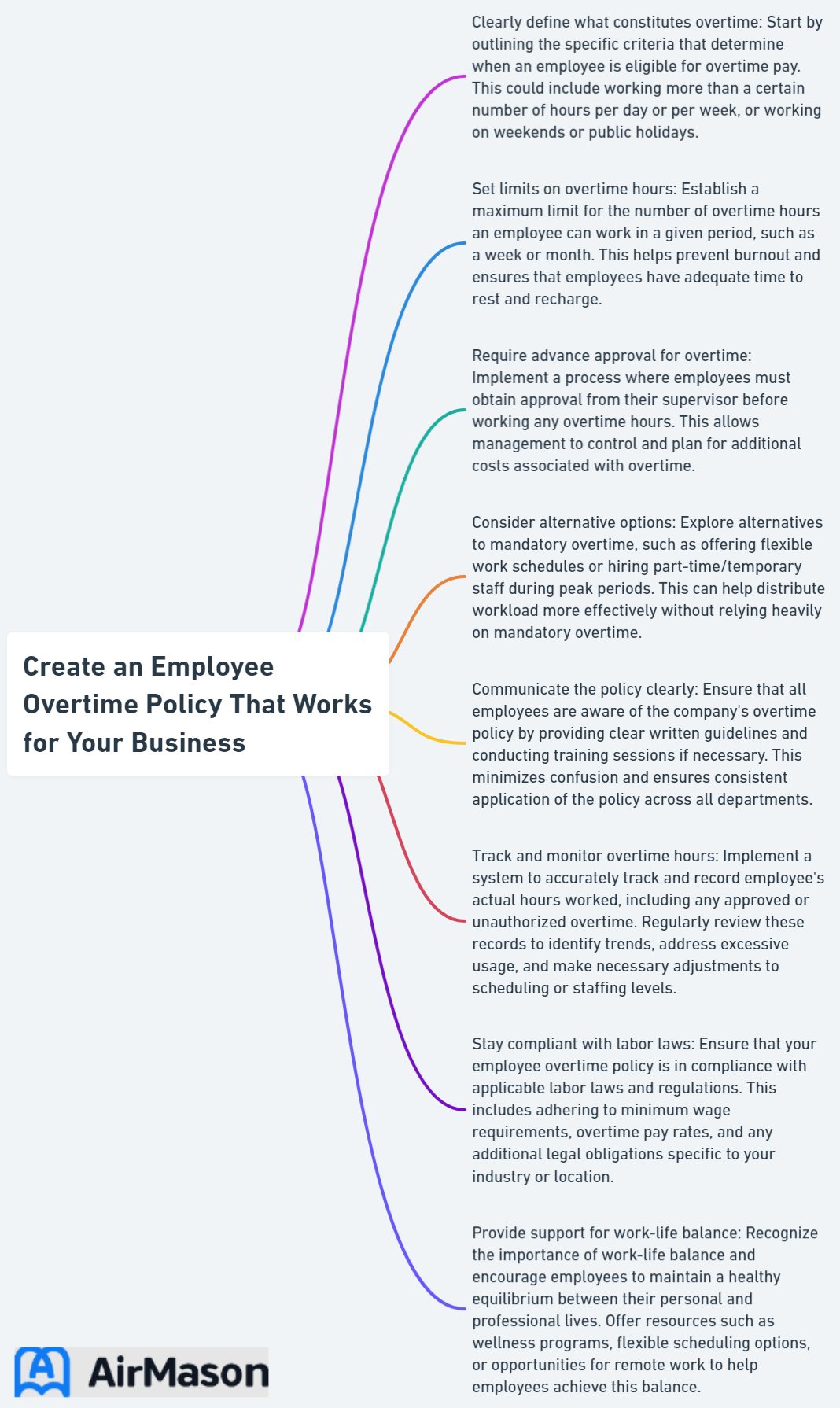
A well-defined employee overtime policy is crucial for the success of any business. It ensures transparency, fairness, and adherence to labor laws, ultimately leading to increased employee satisfaction and productivity. But how do you create an overtime policy that works for your business? In this blog post, we will explore the essential components of an effective overtime policy and provide a customizable template to help you create a policy tailored to your organization’s needs.
By understanding the legal considerations, classifying employees accurately, and addressing health and safety concerns, you can develop a comprehensive overtime policy that benefits both your employees and your business. Let’s dive into the key elements of creating an employee overtime policy that works for your business.
Key Takeaways
- Create an effective overtime policy by understanding legal regulations and classifying employees correctly.
- Establish rules for mandatory/optional overtime, define approval & authorization processes, and detail compensation procedures.
- Implement a healthy work-life balance to prevent burnout & accidents with communication training & proper record keeping.
Employee Health Policies
Employee health policies are crucial components of our organizational framework, outlining the measures and guidelines in place to safeguard the well-being of our workforce. These comprehensive employee health policies encompass a range of initiatives designed to promote physical and mental wellness. From regular health check-ups to wellness programs, our commitment to fostering a healthy workplace underscores our dedication to the holistic welfare of our employees. By prioritizing employee health policies, we aim to create a supportive environment that encourages a balance between professional responsibilities and personal well-being.
Understanding Overtime Policies
A well-thought-out and legally compliant overtime policy plays a vital role in ensuring transparency, fairness, and adherence to labor laws. It also minimizes health and safety risks associated with excessive overtime. However, crafting an effective policy requires a clear understanding of the legal landscape surrounding overtime pay and the classification of exempt and non-exempt employees.
Bear in mind that employees working unauthorized overtime without prior approval from their supervisor or manager won’t be compensated for these extra hours, underscoring the importance of precise record-keeping. Next, we’ll further explore the roles of overtime policies and the legal considerations they entail.

The Role of Overtime Policies
Overtime policies help maintain transparency, fairness, and compliance with labor laws, and they also prevent excessive overtime that could result in employee burnout. In addition, a well-defined policy can help manage employees’ productivity and safeguard their health.
Misusing the overtime system, such as inaccurate timekeeping or non-compliance with overtime pay laws, can lead to legal action against your company. Therefore, it’s of utmost importance that both employees and managers follow the company’s timekeeping systems, maintain accurate records, and ensure precise recording of overtime.
Legal Considerations
Federal and state regulations play a significant role in shaping overtime policies. For instance, the Fair Labor Standards Act (FLSA) governs overtime pay in the United States, stipulating that any work over 40 hours in a 168-hour period is considered overtime and must be compensated accordingly. In addition, state legislation often imposes restrictions on mandatory overtime for certain industries, such as healthcare.
You should acquaint yourself with pertinent federal and state regulations to guarantee your company’s overtime policy aligns with all relevant laws. Next, we’ll examine how to classify employees for overtime, a key aspect of a robust overtime policy.
Classifying Employees for Overtime

A critical step in formulating a productive overtime policy involves the accurate classification of employees as either exempt or non-exempt. This classification determines their eligibility for overtime pay and ensures that your company complies with labor laws regarding overtime compensation.
Exempt employees typically hold executive, administrative, or professional roles and are not eligible for overtime pay, while non-exempt employees are entitled to overtime compensation under the FLSA. Subsequently, we’ll delve into the criteria for exempt and nonexempt employees with more depth.
Exempt Employee Criteria
Exempt employees are not eligible for overtime pay due to their job duties, level of decision-making authority, and salary. To qualify as an exempt employee, an individual must meet the salary level test, salary basis test, and job duties test as stipulated by the FLSA.
The requirements for exempt status under the Fair Labor Standards Act (FLSA) include:
- Salary level test: The employee must earn at least $684 per week, or $35,568 annually, as of January 1, 2020.
- Salary basis test: The employee must receive a pre-determined salary that is not subject to reduction based on the quality or quantity of work performed.
- Job duties test: The employee’s primary job duties must fall into the executive, administrative, or professional categories as defined by the FLSA.
These requirements determine whether an employee is eligible for exempt status and therefore exempt from certain wage and hour provisions of the FLSA.
Non-Exempt Employee Criteria
Non-exempt employees are eligible for overtime pay under the FLSA, regardless of their job duties or salary. These employees must be compensated at a rate of at least one and a half times their regular rate of pay for any hours worked beyond 40 hours in a workweek. It is essential for employers to schedule their employees to work overtime when necessary, ensuring that they are fairly compensated for their additional hours.
Accurate employee classification is vital to guarantee appropriate overtime compensation and maintain compliance with labor laws. Failure to do so may result in fines, penalties, and potential legal action.
Key Components of an Effective Overtime Policy
Having discussed the significance of comprehending overtime policies and classifying employees, we’ll now investigate the main elements of a robust overtime policy. These components include:
- Defining overtime eligibility
- Establishing rules for mandatory and optional overtime
- Outlining the approval and authorization process
- Detailing compensation and payment procedures
In the ensuing sections, we’ll delve into each component in detail, offering insights on formulating a thorough and law-abiding overtime policy.
Defining Overtime Eligibility
Defining overtime eligibility is vital to guarantee accurate compensation for your employees’ overtime work. This includes clearly stating which employees are eligible for overtime pay and under what circumstances.
The eligibility criteria should account for both exempt and non-exempt employees and comply with all applicable legal requirements, such as the FLSA. By clearly outlining overtime eligibility, your employees will have a better understanding of their rights and obligations, and your company will be better equipped to manage overtime effectively.
Establishing Overtime Rules
Setting explicit rules for overtime work is key to managing employee expectations and complying with labor laws. These rules should cover:
- Mandatory overtime
- Optional overtime
- Prohibited overtime
- Limitations on the number of overtime hours that can be worked
For example, your company might decide to limit mandatory overtime to no more than four hours per week, or require employees to obtain approval before working any optional overtime. By setting clear rules, including standard working hours, your company can better manage workloads, reduce the risk of employee burnout, and maintain compliance with labor laws.
Approval and Authorization Process
Detailing the approval and authorization process for overtime work is fundamental for record accuracy and fair employee compensation.
The process should include a procedure for employees to request overtime, as well as guidelines for supervisors to review and approve or deny these requests. By having a well-defined approval and authorization process, your company can better manage overtime hours and ensure that employees are compensated in accordance with labor laws.
Compensation and Payment Procedures
Compensation and payment procedures for overtime work should detail the rates at which overtime hours will be compensated, as well as the pay periods during which employees can expect to receive their overtime pay. These procedures should comply with all relevant federal and state regulations, ensuring that your company remains legally compliant and that your employees are fairly compensated for their overtime work. By detailing compensation and payment procedures, your company can also reduce the risk of disputes and misunderstandings regarding overtime pay, and effectively compensate overtime pay.
Addressing Health and Safety Concerns

Frequent and excessive overtime, sometimes referred to as overtime abuse, can lead to health and safety risks for your employees, as well as decreased productivity and increased turnover. Therefore, it’s vital for your company to mitigate these concerns by limiting overtime hours and promoting a balanced work-life culture.
Subsequently, we’ll discuss strategies like setting limits to work overtime and fostering work-life balance to minimize risks associated with excessive overtime.
Policies and Procedures at Workplace
In fostering a productive and inclusive work environment, our organization is committed to maintaining clear and effective policies and procedures at workplace. These guidelines serve as a framework to ensure consistency, fairness, and accountability across all levels of the organization. Through the implementation of comprehensive policies and procedures at the workplace, we aim to create a transparent and harmonious work culture that supports the well-being and success of our employees. Regular reviews and updates to these policies reflect our dedication to adapting to evolving needs, promoting a dynamic and responsive workplace for all.
Setting Overtime Limits
Establishing limits on the number of overtime hours employees can work is an effective way to prevent burnout and accidents, as well as to maintain productivity and employee well-being. These limits should be based on industry norms, legal requirements, and the unique needs of your business.
By setting overtime limits, your company can ensure that employees have adequate time to rest and recover, reducing the risk of accidents and health issues related to excessive overtime.
Encouraging Work-Life Balance
Encouraging a balanced work-life dynamic is pivotal for your employees’ overall well-being and your business’s long-term prosperity. Discouraging excessive overtime and encouraging employees to take time off can help achieve this balance.
Implement policies that support work-life balance, such as flexible work schedules, paid time off, and mental health resources. By fostering a healthy work-life balance, your company can improve employees health, employee satisfaction, reduce turnover, and increase overall productivity.
Implementing and Monitoring Your Overtime Policy

The implementation and monitoring of your overtime policy are crucial for guaranteeing compliance and effectiveness. This includes:
- Communicating the policy to employees
- Providing training on overtime procedures
- Maintaining accurate records of overtime hours worked
- Ensuring compliance with labor laws
In the ensuing sections, we’ll discuss the significance of communication, training, record keeping, and compliance in the implementation and monitoring of your overtime policy.
Communication and Training
Clear communication of your overtime policy and providing training on overtime procedures are crucial to ensure compliance and prevent any misunderstandings or conflicts. Utilize multiple channels of communication, such as company-wide meetings, email announcements, and posting the policy in common areas.
Additionally, provide training to employees on the policy, including the approval and authorization process, to ensure that everyone is aware of their rights and responsibilities regarding overtime.
Record Keeping and Compliance
Keeping precise records of overtime hours and ensuring adherence to labor laws are vital for your overtime policy’s success. It is essential to record overtime hours accurately, as managers accurately record overtime to maintain compliance and avoid potential issues.
Utilize employee scheduling software to:
- Track employee working hours and overtime
- Establish a system for employees to report their hours worked
- Monitor overtime hours regularly to ensure compliance with the overtime policy
By maintaining accurate records and ensuring compliance with labor laws, your company can minimize the risk of fines, penalties, and potential legal action.
Customizable Company Overtime Policy Template

To help you create an overtime policy that works for your business, we have provided a customizable company overtime policy template. This template can assist you in constructing your own policy, with customizability being a key feature.
In the subsequent sections, we’ll overview the template and provide tips for customization, helping you create an overtime policy tailored to your organization’s unique needs and requirements.
Template Overview
The customizable company overtime policy template includes sections that address:
- Defining overtime eligibility
- Establishing rules for mandatory and optional overtime
- Outlining the approval and authorization process
- Detailing compensation and payment procedures.
These sections are designed to be easily customized to fit your business’s specific needs and requirements, ensuring that your overtime policy is both comprehensive and legally compliant.
Customization Tips
When adjusting the template, consider modifying the rules and regulations, customizing the eligibility criteria, defining the approval process, and addressing compensation and benefits. Be sure to review and align with company policies, scale for a larger workforce, and incorporate flexibility to accommodate the unique needs of your organization.
By following these customization tips, you can create an overtime policy that effectively manages employee overtime and ensures compliance with labor laws, ultimately benefiting both your employees and your business.
Policy for Working Remotely
Our “Policy for Working Remotely” is designed to provide clear guidelines and expectations for employees who choose to work outside the traditional office setting. This policy outlines the criteria for remote work eligibility, the necessary approval process, and the responsibilities of both employees and managers. We believe that fostering a flexible work environment can enhance productivity and work-life balance. It is essential for all team members to familiarize themselves with the details of our “Policy for Working Remotely” to ensure a seamless and successful remote work experience. snapsex
Summary
In conclusion, creating an employee overtime policy that works for your business involves understanding overtime policies, classifying employees accurately, addressing health and safety concerns, and implementing key components such as eligibility, rules, approval, and payment procedures. By using our customizable company overtime policy template and following the customization tips provided, you can create a tailored policy that meets your organization’s unique needs and requirements.
Remember, a well-defined and legally compliant overtime policy is crucial for the success of any business, ensuring transparency, fairness, and adherence to labor laws. Invest in your employees’ well-being and your company’s future by developing and implementing an effective overtime policy.
Frequently Asked Questions
What is an example of a company overtime policy?
As an example, a company’s overtime policy may stipulate that employees can work a maximum of four overtime hours each week. Furthermore, the company reserves the right to request all employees to work overtime during busy periods and pays time and a half for additional hours beyond a certain number.
What is the mandatory overtime clause?
Mandatory overtime, allowed under FLSA, is a clause requiring employers to pay their employees 1.5 times the standard wage for any hours exceeding 40 per workweek, and guaranteeing that the employee will not be put in jeopardy due to enforced overtime.
How do you justify overtime hours?
Overtime hours can be justified as necessary for providing 24/7 coverage, responding to workload fluctuations, managing staff variations, and considering the labor market.
What is overtime and how does it work?
Overtime is when employees work more than their normal hours, and they must be paid a rate of time-and-a-half for the extra hours worked. This is required by federal laws under the Fair Labor Standards Act and will vary from state to state. The overtime rate must be at least 1.5 times the employee’s hourly pay rate.
What is the importance of having a well-defined overtime policy?
Having a well-defined overtime policy is essential for ensuring fairness, transparency, and compliance with labor laws, resulting in increased employee satisfaction and productivity.